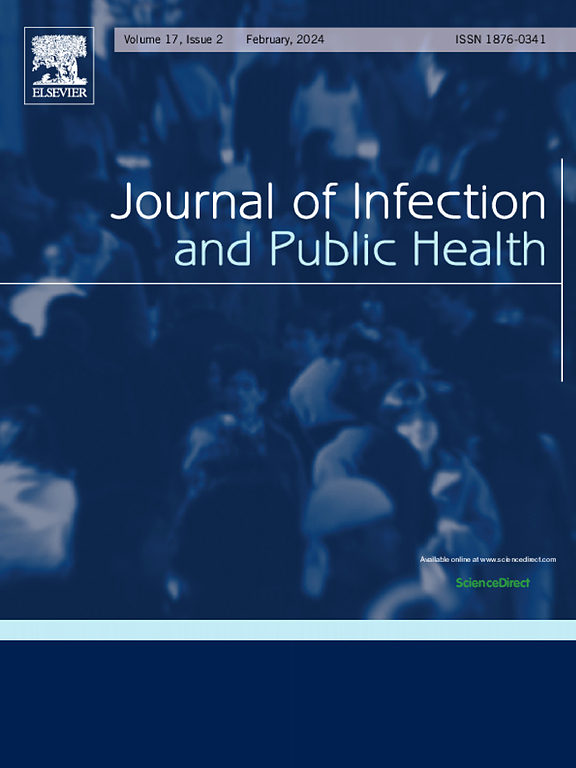致命疫情中广泛耐药和多重耐药鲍曼不动杆菌ST208分离株的基因组可塑性
IF 4.7
3区 医学
Q1 INFECTIOUS DISEASES
引用次数: 0
摘要
背景:耐多药鲍曼不动杆菌(MDRA)的流行迅速增加,并与严重的医院感染有关。使用全基因组测序分析了日本一家医院的MDRA暴发。方法对2009年和2010年暴发前后住院患者临床分离株进行抗生素药敏试验。全基因组测序鉴定获得性耐药基因和基因突变。结果鲍曼不动杆菌临床分离株对β-内酰胺类药物(广谱头孢菌素和碳青霉烯类药物)、氨基糖苷类药物、氯霉素、磷霉素、氟喹诺酮类药物、四环素类药物和甲氧苄啶-磺胺甲恶唑耐药。MDRA分离株含有aac(6′)-Ib-cr、abaF、armA、blaADC-30、blaem -1和blaOXA-82,或blaOXA-66和blaOXA-23、catB8、mphE、msrE和tet(B)。重组blaOXA-82基因。喹诺酮类药物耐药也与gyrA S81L和parC S84L突变有关。分离株属牛津序列型(ST) 208和巴斯德序列型(ST2)。15株分离株中有3株出现广泛耐药表型,2株存在adeS突变。结论在3株XDR和1株MDR分离株中鉴定出了耐药分子标记,并提供了耐药性和毒力的基因组描述,以及分离株的来源。分离株与在亚洲和澳大利亚发现的MDRA Oxford ST208和Pasteur ST2密切相关。MDRA分离株在西太平洋区域的医院和社区环境中都令人关切。本文章由计算机程序翻译,如有差异,请以英文原文为准。
Genomic plasticity of extensively drug-resistant and multidrug-resistant Acinetobacter baumannii ST208 isolates from a fatal outbreak
Background
The prevalence of multidrug-resistant Acinetobacter baumannii (MDRA) has rapidly increased and is linked to severe nosocomial infections. MDRA outbreaks in a Japanese hospital were analysed using whole-genome sequencing.
Methods
Antibiotic susceptibility testing was performed on clinical isolates from hospitalised patients before and during the 2009 and 2010 outbreaks. Whole-genome sequencing was conducted to identify acquired antibiotic-resistance genes and genetic mutations.
Results
Clinical A. baumannii isolates were resistant to β-lactams (broad-spectrum cephalosporins and carbapenems), aminoglycosides, chloramphenicol, fosfomycin, fluoroquinolones, tetracyclines, and trimethoprim-sulfamethoxazole. MDRA isolates harboured aac(6′)-Ib-cr, abaF, armA, blaADC-30, blaTEM-1, and blaOXA-82, or both blaOXA-66 and blaOXA-23, catB8, mphE, msrE, and tet(B). blaOXA-82 genes were recombinationally multiplied. Quinolone resistance was also associated with gyrA S81L and parC S84L mutations. The MDRA isolates belonged to Oxford sequence type (ST) 208 and Pasteur ST2. Three of the 15 isolates developed an extensively drug-resistant (XDR) phenotype, and two isolates harboured an adeS mutation.
Conclusions
We identified molecular resistance markers in three XDR and one MDR isolate and provided a genomic description of resistance and virulence, as well as the origins of the isolates. The isolates are closely related to MDRA Oxford ST208 and Pasteur ST2, identified in Asia and Australia. MDRA isolates are of concern in both hospital and community settings in the Western Pacific region.
求助全文
通过发布文献求助,成功后即可免费获取论文全文。
去求助
来源期刊

Journal of Infection and Public Health
PUBLIC, ENVIRONMENTAL & OCCUPATIONAL HEALTH -INFECTIOUS DISEASES
CiteScore
13.10
自引率
1.50%
发文量
203
审稿时长
96 days
期刊介绍:
The Journal of Infection and Public Health, first official journal of the Saudi Arabian Ministry of National Guard Health Affairs, King Saud Bin Abdulaziz University for Health Sciences and the Saudi Association for Public Health, aims to be the foremost scientific, peer-reviewed journal encompassing infection prevention and control, microbiology, infectious diseases, public health and the application of healthcare epidemiology to the evaluation of health outcomes. The point of view of the journal is that infection and public health are closely intertwined and that advances in one area will have positive consequences on the other.
The journal will be useful to all health professionals who are partners in the management of patients with communicable diseases, keeping them up to date. The journal is proud to have an international and diverse editorial board that will assist and facilitate the publication of articles that reflect a global view on infection control and public health, as well as emphasizing our focus on supporting the needs of public health practitioners.
It is our aim to improve healthcare by reducing risk of infection and related adverse outcomes by critical review, selection, and dissemination of new and relevant information in the field of infection control, public health and infectious diseases in all healthcare settings and the community.
 求助内容:
求助内容: 应助结果提醒方式:
应助结果提醒方式:


